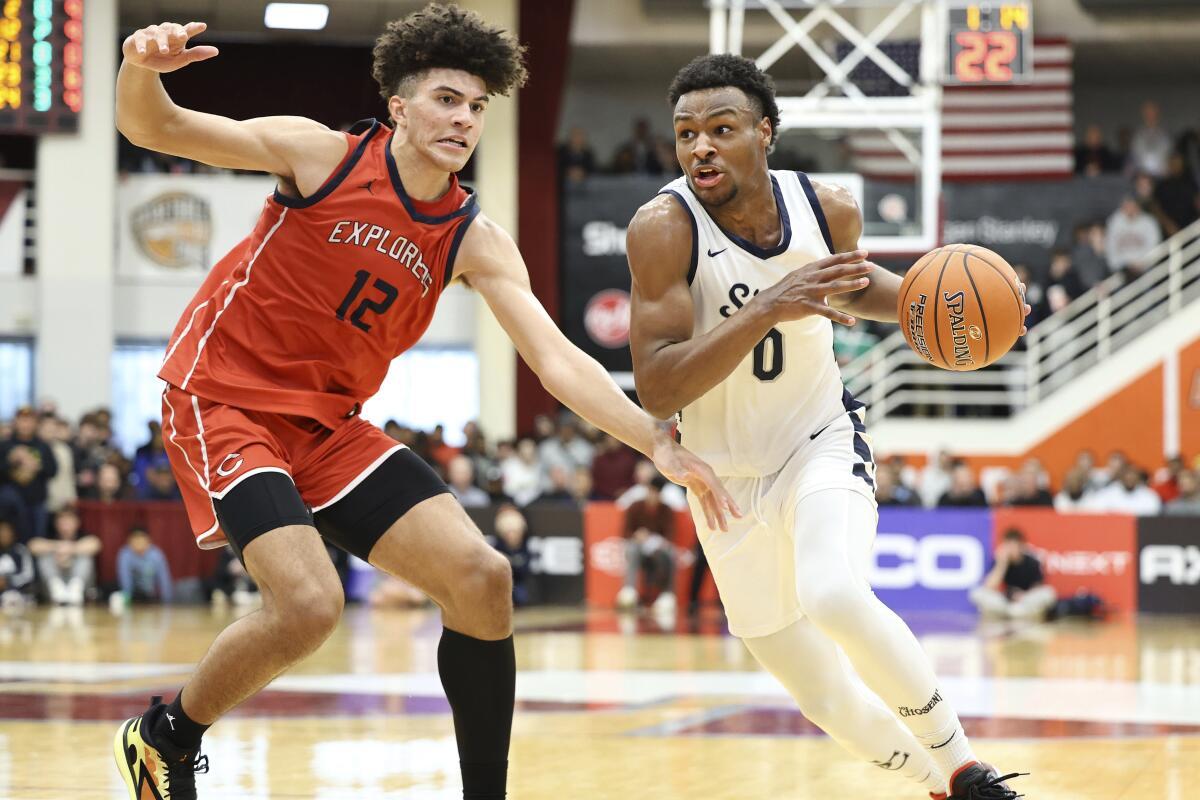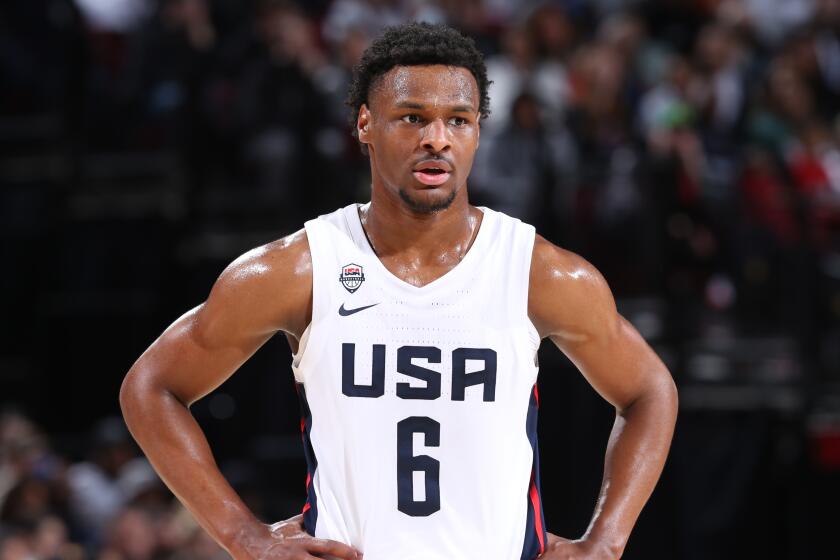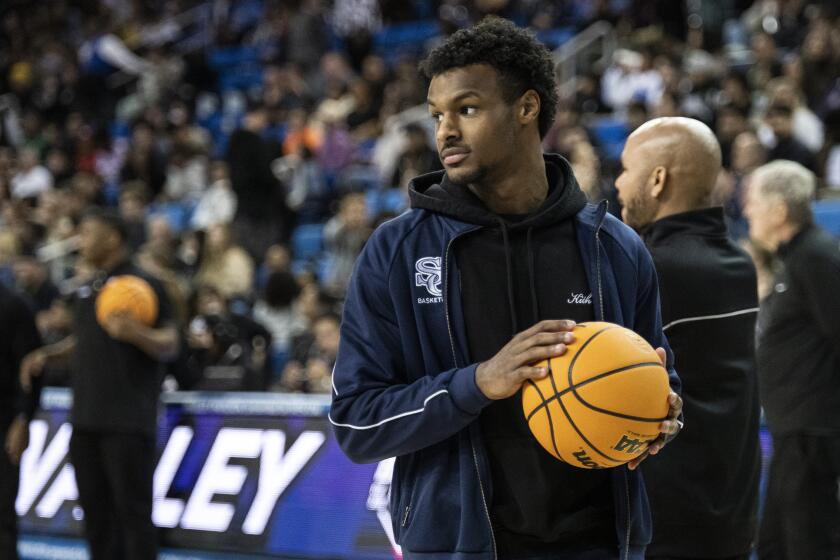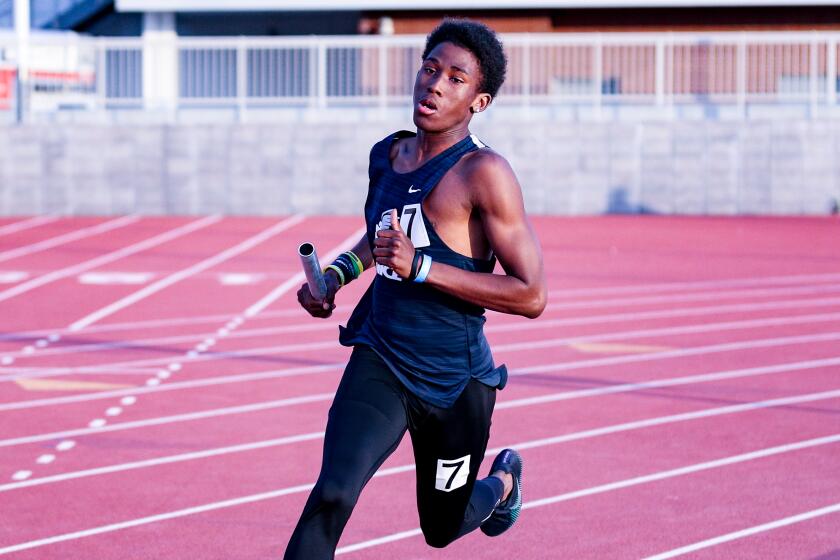When disaster struck, Bronny James got help. But LAUSD athletes often aren’t as lucky

- Share via
LeBron James and his wife, Savannah, thanked USC medical and athletic staff for treating Bronny James when he suffered cardiac arrest during a USC workout Monday.
The same support would’ve been there for James at his alma mater, private school Sierra Canyon High, who employ an athletic training staff seen at James’ games.
But there is a harshly different reality for many athletes in Los Angeles-area public high schools — a glaring example of the ever-widening differential in resources available for students in different socioeconomic pockets of Southern California.
“We’re miles apart,” Roosevelt High football coach Aldo Parral said of the gap between public and private school care. “And it’s like two different worlds.”
The 18-year-old son of Lakers star LeBron James suffers cardiac arrest during a USC workout Monday. His family says he is in stable condition.
California is the only state in the country that does not regulate athletic trainers, which means some schools rely on lightly trained coaches and volunteers instead of certified medical personnel.
There are eight athletic trainers employed at Los Angeles Unified School District campuses, according to district employees. More than 150 high schools compete in the Los Angeles City Section. Members of the California Athletic Trainers’ Assn. (CATA) said during an April summit that 95% of schools in L.A. don’t field a certified athletic trainer.
“You took these courses, and prepared as best as you could,” Garfield High football coach Lorenzo Hernandez said, referring to first aid preparations City Section coaches are required to adhere to. “But honestly, being out there is scary.”
Venice’s Nathan Santa Cruz, who nearly died from a head injury during a football game last year and was saved, in part, by an emergency plan from athletic trainer Kirsten Farrell, highlights the benefit of athletic training services at games and practices.
The concerns aren’t limited to head or cardiac events. LAUSD athletes often compete on practice fields dull with weeds, where concussions and broken bones have left coaches with no medical experience frustrated. The only solution, as Los Angeles High’s Anthony Jackson said, is “to hold them steady until the paramedics come.”
Bronny James, a USC basketball freshman and son of LeBron James, suffered a cardiac arrest at practice. Magic Johnson and others offer their support.
“If a kid dislocates his finger, I don’t want to put the finger back in place,” said South Gate basketball coach Al Rangel, who had to step away from a playoff game last winter momentarily to assess whether a player who’d suffered a cut on the head had a concussion. “Because what if I put it in the wrong way? Or he dislocated the elbow? Like, I don’t know how to do that. Or, he faints. What do we do?”
This issue of access, advocates say, is not just a healthcare issue, but a social justice issue. The Times used the Athletic Training Locations and Services (ATLAS) project — a NATA initiative charting athletic trainers at schools across the nation — to compile a random sample of 100 high schools in the greater Los Angeles area that competed in either the Southern Section or City Section, then cross-referenced the presence or lack of an athletic trainer with each school’s student-body ethnicity demographics compiled by US News & World Report.
Nine months ago Venice High football player Nathan Santa Cruz suffered a head injury that required brain surgery. Now he’s helping set records in track.
The median minority-student population at sampled schools without an athletic trainer, The Times found, was 95.25%. The median at schools with a trainer was 75.1%.
LAUSD is increasing efforts to improve services across the district, with Farrell last year transitioning into a new role helping increase districtwide opportunity for athletic training services. Fairfax High, for one, is attempting to reallocate its budget — often the main barrier in the district to wider services — to create room for a salaried athletic training position that would pay around $100,000 a year, Principal Leonard Choi said in June.
“Here we are, as a public school, competing against some of the top schools in the country sometimes … we weren’t afforded [trainers,]” Choi said. “And so there’s a huge disparity gap.”
More to Read
Go beyond the scoreboard
Get the latest on L.A.'s teams in the daily Sports Report newsletter.
You may occasionally receive promotional content from the Los Angeles Times.










